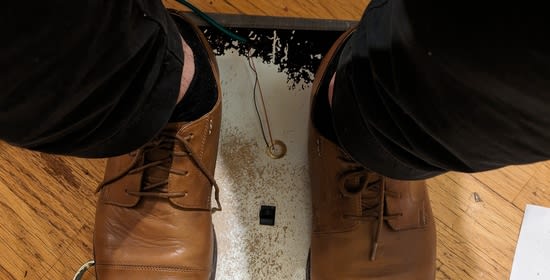Experimenting With Footboard Piezos
post by jefftk (jkaufman) · 2024-02-11T03:00:05.131Z · LW · GW · 2 commentsContents
2 comments
In playing for contra dances it's rare to have a drummer. You mostly see them at big events where the finances work out for a fourth or fifth musician: in trio, or especially a duo, you generally can't allocate anyone just to drums. What you do see a lot of, however, is a musician playing foot percussion in addition to something else. There are a range of ways to do this technically (I wrote a post with lots of examples) but the most common is acoustic " French Canadian feet".
You can bring a board and ask the sound person to point a mic at it, but what you get will depend a lot on how the physical material of the stage responds. Instead, it's common for musicians to put together a piezo and a piece of wood, to get consistently good sound from gig to gig.
A friend wrote to me to say they'd been having trouble getting a sound they liked from their board, and asked if I could help them debug it. I'm not really the ideal person to ask, since I've never ended up with an acoustic sound I'm happy with and have switched over to electronic, but I was game to play around.
I set us up with a mixer, recording interface, laptop, and PA speaker. The goal was that we could hear the feet as we played them, but more importantly we could listen back without the acoustic component so we could tell how they'd sound in a hall. And we could make recordings, so we could compare new configurations to older ones without relying on memory.
Initially my hypothesis was that their DI wasn't high enough impedance. This had a large effect when I tested it with my electric mandolin, and it's something people talk about a lot. After a few trials, however, we realized that the location of the piezo and the shoe material had a much larger effect.
For example, here are recordings from an MXR M222 (which I liked a lot last time) and a Radial ProDI (which is a good passive DI but should lose some bass):
They don't sound the same, but compare this delta to what we got from changing the placement from nearer the toes to nearer the heels:
Or switching shoes (though this also meant switching people, so it's not entirely fair):
Or even trying it barefoot (both from the same person):
We didn't end up getting to something we liked because we didn't start until after my kids were asleep and I was only good for an hour or so, but I'd be excited to explore more in this direction to find the ideal combination of shoe material and piezo placement.
(One of the things that made this annoying was that we started getting 60Hz hum from first one and then both piezos. I'm not sure what caused it: the second piezo was totally hum-free initially, as confirmed by the recordings, and then at one point started humming and didn't stop no matter what we changed.)
2 comments
Comments sorted by top scores.
comment by Jeremyy · 2024-02-11T13:45:15.356Z · LW(p) · GW(p)
I’ve experimented quite a bit with piezos on percussion. The only thing I’ve found remotely decent was the Zeppelin Design Labs Cortado MK II. I’ve used it with a LP Laptop Conga (attached with blue tack). If you slide your hands at all you get a lot of whooshy white noise, and you can get noise from jostling the cable, but otherwise it sounds pretty much like a normal microphone minus any room ambiance. Apparently they also use them under basketball courts for TV broadcasts.
It’s a bit on the expensive side but they have a much cheaper DIY kit version if you are at all handy with electronics. It does require phantom power.
Replies from: Jeremyy